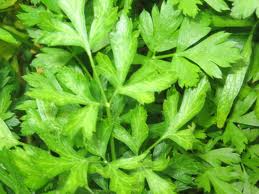
by Michelle Dwyer | Aug 29, 2016 | Blog, Health, Nutrition, Recipes, Vegetarian/vegan
PARSLEY
Fun fact! Parsley was thought to be sacred by the ancient Greeks and has been cultivated for over 2,500 years. It is a rich, dense source of vitamin C, K and E, as folic acid and iron. And, is extremely rich in the minerals calcium and potassium and has high percentages of carotenoids and flavonoids.
 Health Benefits:
Health Benefits:
- Parsley contains volatile oils that have been shown to inhibit tumor formation and increase antioxidant formation in the blood.
- Its carminative properties reduces flatulence and colic.
- Parsley is an emmenagogue, meaning it stimulates the menses, therefore be cautious and do not use in large amounts if you’re currently pregnant.
- Does parsley have any other special attributes? Yes. Parsley is an excellent breath freshener!
Adding parsley to your cooking and recipes not only enhance brightness and flavor but it’s also easy and fun to explore new ways to incorporate them in.
Ways to use parsley in your cooking:
- Add chopped fresh parsley to salads, soups, sauces, vegetable sautés and grilled meats.
- Add to pesto sauce for more texture and green color.
- Tabbouleh salad with parsley, bulgur wheat or quinoa, garlic,mint, lemon juice and olive oil.
- Great for juicing or when making broths.
- Easy tapenade with parsley, olives, pistachios, and olive oil: This is one of my FAVORITE recipes and is always a hit at parties!
TIP: Add fresh parsley at the end of cooking to retain its color, flavor and freshness!
Recipe: Parsley Tabbouleh
Servings: 4
1 small cucumber, peeled, seeded and diced
4 scallions, thinly sliced
1 cup water
1/2 cup bulgur or quinoa
1/4 cup lemon juice
2 tablespoons extra-virgin olive oil
1/2 teaspoon minced garlic
1/4 teaspoon salt
1/4 cup chopped fresh mint
2 tomatoes, diced
Freshly ground pepper, to taste
2 cups finely chopped flat-leaf parsley, (about 2 bunches)
- Combine water and bulgur or quinoa in a small saucepan. Bring to a full boil, remove from heat, cover and let stand until the water is absorbed and the bulgur/quinoa is tender, 25 minutes or according to package directions. If any water remains, drain bulgur/quinoa in a fine-mesh sieve. Transfer to a large bowl and let cool for 15 minutes.
- Combine lemon juice, oil, garlic, salt and pepper in a small bowl. Add parsley, mint, tomatoes, cucumber and scallions to the bulgur. Add the dressing and toss.
- Serve at room temperature or chill for at least 1 hour to serve cold.
Make Ahead Tip: Cover and refrigerate for up to 1 day.
Recipe adapted from EatingWell.com
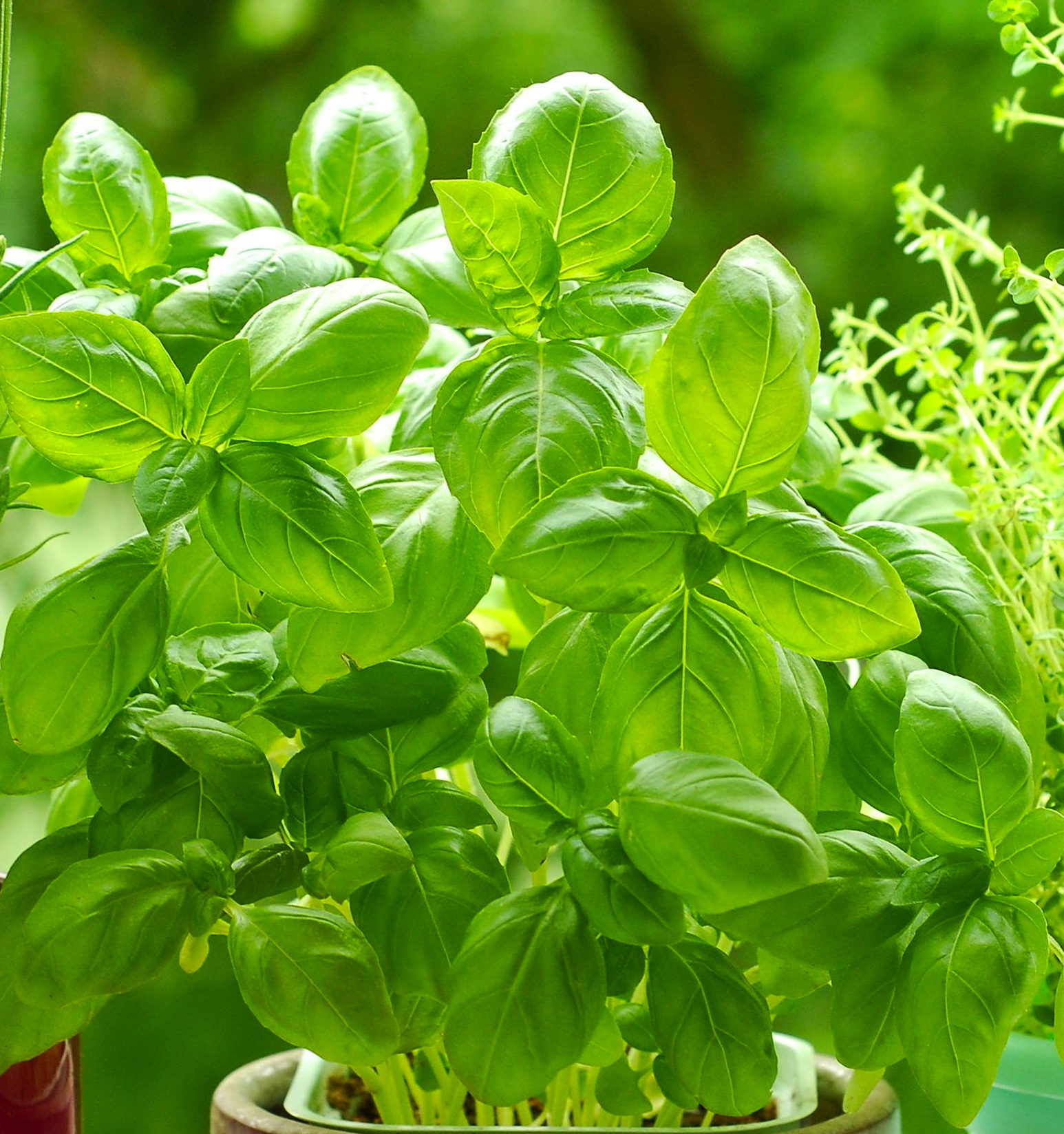
by Michelle Dwyer | Jul 4, 2016 | Blog, Health, Nutrition, Recipes, Vegetarian/vegan
I’m very excited to start this Herb Series on various culinary herbs. Each post will highlight a particular herb and easy ways to incorporate it into your daily eating.
Herbs are such a nutritious and delicious way to upgrade your nutrition!
So let’s start with a favorite: BASIL!
Fun fact! There are more than 60 varieties of basil besides the sweet basil we are most familiar, including lemon basil, Thai basil, cinnamon basil and holy basil.
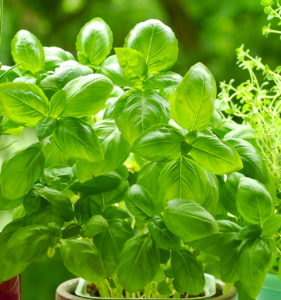 Benefits of BASIL
Benefits of BASIL
- good source of flavonoids, particularly those found to protect cell structures and chromosomes from radiation and oxidation
- antibiotic and anti-inflammatory properties
- effective in restricting growth of certain bacteria namely e coli and staphylococcus aureus
- good source of vitamins K, A, calcium and potassium and beta-carotene
BASIL in cooking and recipes
- Pesto with garlic, olive oil and a nut (walnuts, pine nuts, pistachios)
- Add to fruit and fruit smoothies for a refreshing twist. Especially delicious with watermelon and other melons!
- Add to water with slices of citrus for a pretty and tasty treat
- Caprese salad of mozzarella, tomatoes and basil
- Add to the top of stir fry, pasta dishes or soups for a fresh taste and added flavor
Tip: Store basil in the refrigerator wrapped in a paper towel in a plastic bag. Can also be frozen. Even better idea is to buy a basil plant! Very easy to grow!
Want some basil inspiration? Check out this Huffington Post article with over 34 ways to use basil in a recipe! Yum!
What’s your favorite way to use basil?
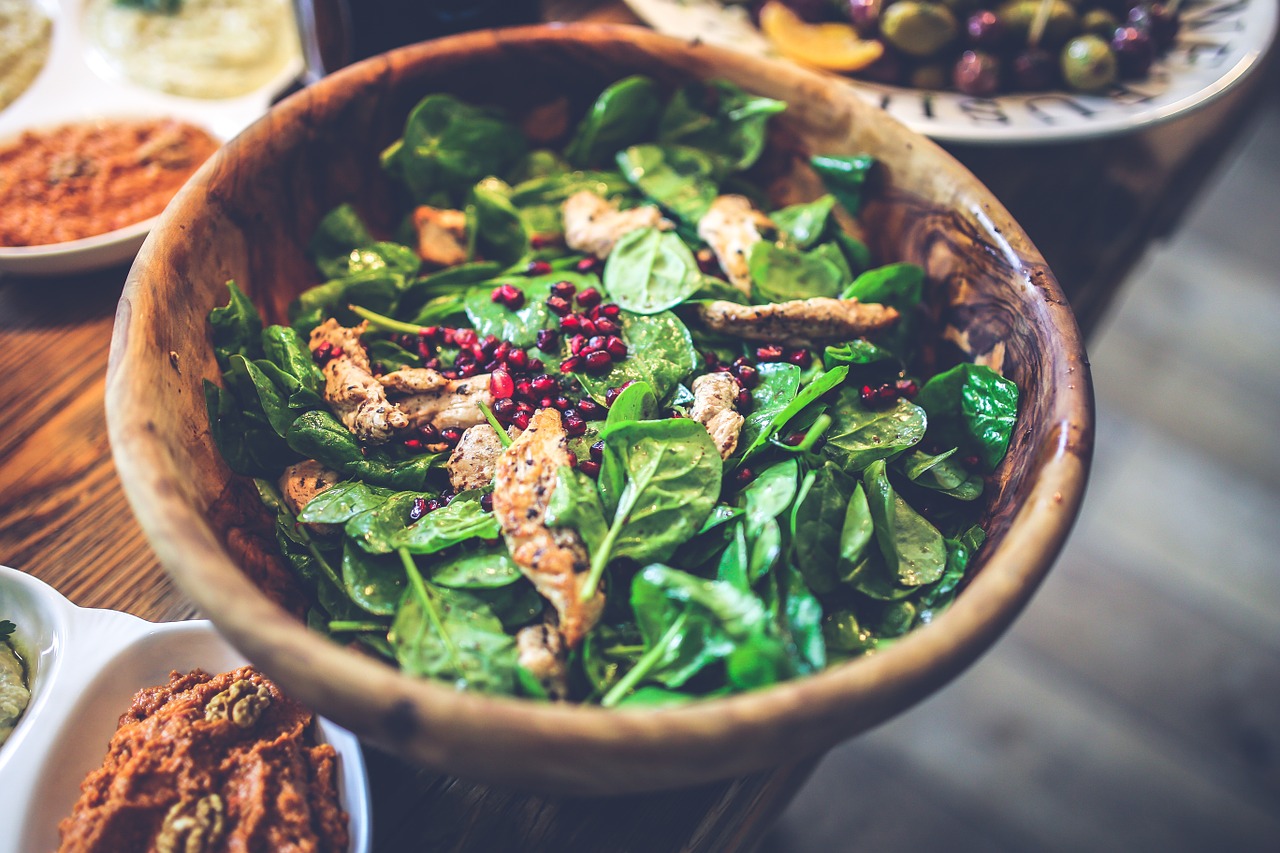
by Michelle Dwyer | Sep 3, 2015 | Blog, Health, Recipes, Vegetarian/vegan
I was inspired to write this post based on a recent article that claimed salads had no nutritional value and should be avoided. I won’t bother sharing the article, from a major daily publication, but I will say that if you are talking about iceberg lettuce drowned in highly processed dressings full of unhealthy fats, sugar and additives, then yes I would agree. However, maybe it is because I’m from California or maybe it’s because I think of salad SO differently, but I think a hearty salad is not only very nutritious but delicious as well! The key: choose quality ingredients and go for variety!
Here’s my easy “Build a Hearty Salad” formula:
-
Choose a protein
-
Choose some vegetables
-
Choose some greens
-
Add some healthy fats
-
Optional: add some beans
-
Optional: add some whole grains, starchy vegetables or fruit

Protein: 3 oz (size of a deck of cards)
- chicken
- turkey
- grass-fed beef
- fish or shellfish
- hard boiled egg
- cheese*
- edamame
- tofu
- tempeh
- beans or lentils*
Vegetables: Pick 2 or more (1+ cup total)
- asparagus
- broccoli
- cauliflower
- cucumber
- red bell pepper
- green beans
- tomatoes
- zucchini
- carrots
- artichoke hearts
- onions
- mushroom
Greens: 1-2 cups
- cabbage
- kale
- mixed greens
- spinach
- arugula
- fresh herbs like parsley, cilantro, dill or basil
Healthy fats: 1-2 T.
- Nuts and seeds: almonds, walnuts, sunflower seeds, pistachios, pumpkin seeds, peanuts, pine nuts, Brazil nuts, hemp seeds, chia seeds, flax seeds
- cheese*
- olive oil
- avocado
- olives
Beans & legumes: ½ cup (optional)
- beans: garbanzo, black, pinto, kidney, white or cannellini
- lentils
Whole Grains, Starchy Vegetables or Fruit: 1/3- 1/2 cup (optional)
- quinoa
- barley
- millet
- bulgur
- brown rice
- sweet potato or yams
- beets
- winter squash like roasted butternut or delicata
- pomegranate seeds
- berries like strawberries or blueberries
- fresh figs
- citrus like orange or grapefruit
- mango
*some foods could count in either category: for example, cheese could be a protein or a fat and beans/lentils could be the protein in the salad or added for more fiber!
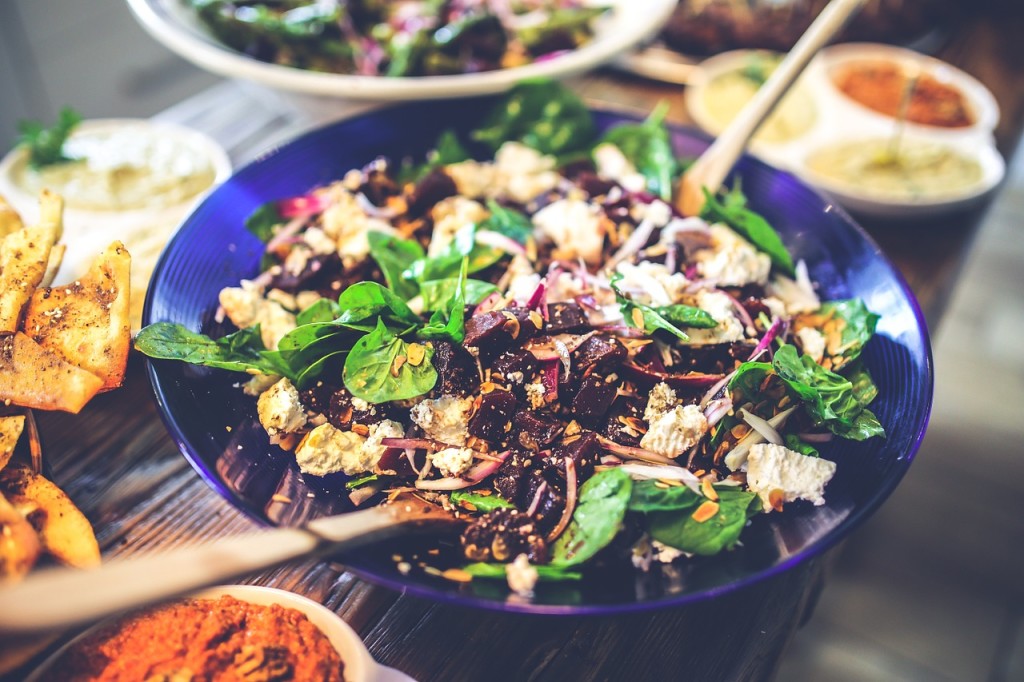
A few other tips and suggestions for building your hearty salads:
- Choose organic whenever possible! See my previous post on Buying Organic for more information.
- Go for variety and start with ingredients you love. The beauty of this list is to mix and match with the nutritious foods you already enjoy eating. Be creative!
- Raw vegetables hard for you to digest? No problem. Lightly steam vegetables and then cool and store them for salads later. Or use leftover roasted vegetables from a previous meal. In fact, the entire “salad” can be thrown into a pan on medium heat and eaten as stir-fry if your body doesn’t do well on raw or it’s winter and your body wants warm food.
- Don’t skip the fat! You need healthy fats to help you absorb those wonderful fat-soluble vitamins like A, E, and K.
- Don’t have time to make a salad every day? Consider my favorite thing: Salad in a Jar (lots of great ideas on this post too!)
- Most pre-made dressings are full of sugar, processed oils, and additives. There are a few better options out there, but in general I suggest making your own dressings. (See below for a few ideas and suggestions.) If you are out or don’t have a lot of time, fresh lemon juice, olive oil and a little black pepper will always be delicious!
Easy Dressings
Balsamic Vinaigrette
- 3/4 cup extra-virgin olive oil
- 1/4 cup balsamic vinegar
- Sea salt
- Fresh-ground pepper
- Optional extras: spoonful of mustard, minced shallots, minced garlic, minced fresh herbs, teaspoon dried herbs, small spoonful of honey or maple syrup
“Creamy” Greek Dressing
- 1-2 tablespoons of olive oil
- 1 tablespoon Dijon or stone-ground mustard
- 2-3 tablespoons of tahini or hummus (to taste)
- 1-2 tablespoons of lemon or apple cider vinegar
- sea salt and pepper to taste
- optional: fresh or dried dill
- water to thin, if necessary
Asian-Style Dressing
- 1/4 cup orange juice
- 1 tablespoon of orange zest
- 1/4 cup rice vinegar
- 1 tablespoon toasted sesame oil
- 1 teaspoon fresh ginger, finely grated
- EITHER 2 tablespoons reduced-sodium tamari, reduced-sodium soy sauce, or Bragg’s amino acids OR 1 ½ tablespoons of white miso
Lemon-Mint Vinaigrette
- 1/3 cup lemon juice
- 1 tablespoon Dijon or stone-ground mustard
- 1 clove garlic, minced
- 1/3 cup extra-virgin olive oil
- 1/3 cup chopped fresh mint
- 1/8 teaspoon salt
- Freshly ground pepper, to taste
- Optional: dash of honey or maple syrup
What is your favorite thing to put into a salad? Do you have a go-to combination that works for you or do you like to mix it up?

by Michelle Dwyer | Jun 7, 2015 | Blog, Health, Recipes, Vegetarian/vegan
I love making smoothies and have one for breakfast just about every day. It’s a yummy, easy way to make sure I’m getting a good amount of protein to start the day plus some great nutrients. I’ve posted about protein powder before, but wanted to give everyone some more ideas for what to put in their smoothies. I’ve adapted my suggestions from the No Meat Athlete’s Perfect Smoothie Formula post.
Basic Ingredients:
- 1/2 cup frozen or fresh fruit
- 2-4 tablespoons protein powder
- 1-2 tablespoons binder
- 1/2 cup of greens or veggies
- 1 tablespoon oil
- 1/2 soft fruit
- sweetener (optional, less or more as needed)
- 8-10 ounces of liquid
- optional superfoods, greens, and other ingredients (see below)
- 3 ice cubes (omit if fruit is frozen or if you don’t want it too cold)
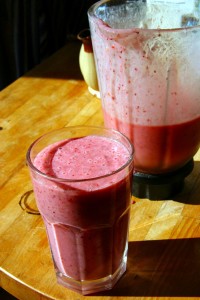 Directions: Select one or more ingredients of each type below and add to blender in specified proportions. Blend until smooth.
Directions: Select one or more ingredients of each type below and add to blender in specified proportions. Blend until smooth.
VARIATIONS AND CHOICES FOR SMOOTHIE INGREDIENTS
Frozen or Fresh Fruits
- Strawberries
- Blueberries
- Blackberries
- Raspberries
- Peaches
- Mango
- Pineapple
Protein Powders
- Hemp (ground whole hemp or shelled hemp hearts)
- Pea protein powder
- Vega brand protein powders (sweetened with stevia)
- Sprouted brown rice
- Lifetime Life’s Basic’s Plant Protein
- Collagen hydrolysate (NOT vegetarian)
(Note: Soy and whey are higher-protein options, but for a variety of reasons I don’t recommend either for long-term use)
Binders
- Ground or soaked flaxseed
- Almond butter or any nut butter
- Soaked raw almonds (soak for several hours and rinse before using)
- Rolled oats, whole or ground (as tolerated)
Greens/Veggies
- Spinach
- Frozen kale (blends a bit better)
- Lettuce
- Zucchini
- Cucumber
Oils
- Flaxseed oil
- Udo’s Blend or other EFA blend
- Hemp oil
- Coconut oil
- Almond, macadamia, or other nut oil
Liquids (unsweetened)
- Water
- Almond milk or other nut/seed milk
- Hemp milk
- Brewed tea (green or herbal)
Soft Fruit
- Avocado
- Banana (avoid if keeping to a lower sugar eating plan)
- If you have a high-speed blender that can puree a whole fruit or vegetable without leaving any chunks behind, then almost any fruit or vegetable can act as your soft fruit
Sweeteners (optional or use sparingly)
Superfoods, Greens and Other Ingredients
- Cacao nibs or carob chips (1-2 tablespoons)
- Ground organic cinnamon (1-2 teaspoons)
- Chia seeds, whole or ground (1-2 tablespoons)
- Greens powder (1-2 teaspoons)
- Maca powder (1-2 teaspoons)
- Sea salt (pinch)
- Lemon or lime juice (1 tablespoon)
- Vanilla or almond extract (1-2 teaspoons)
There are so many possibilities and options with smoothies, so be creative and find the combination that works for you!
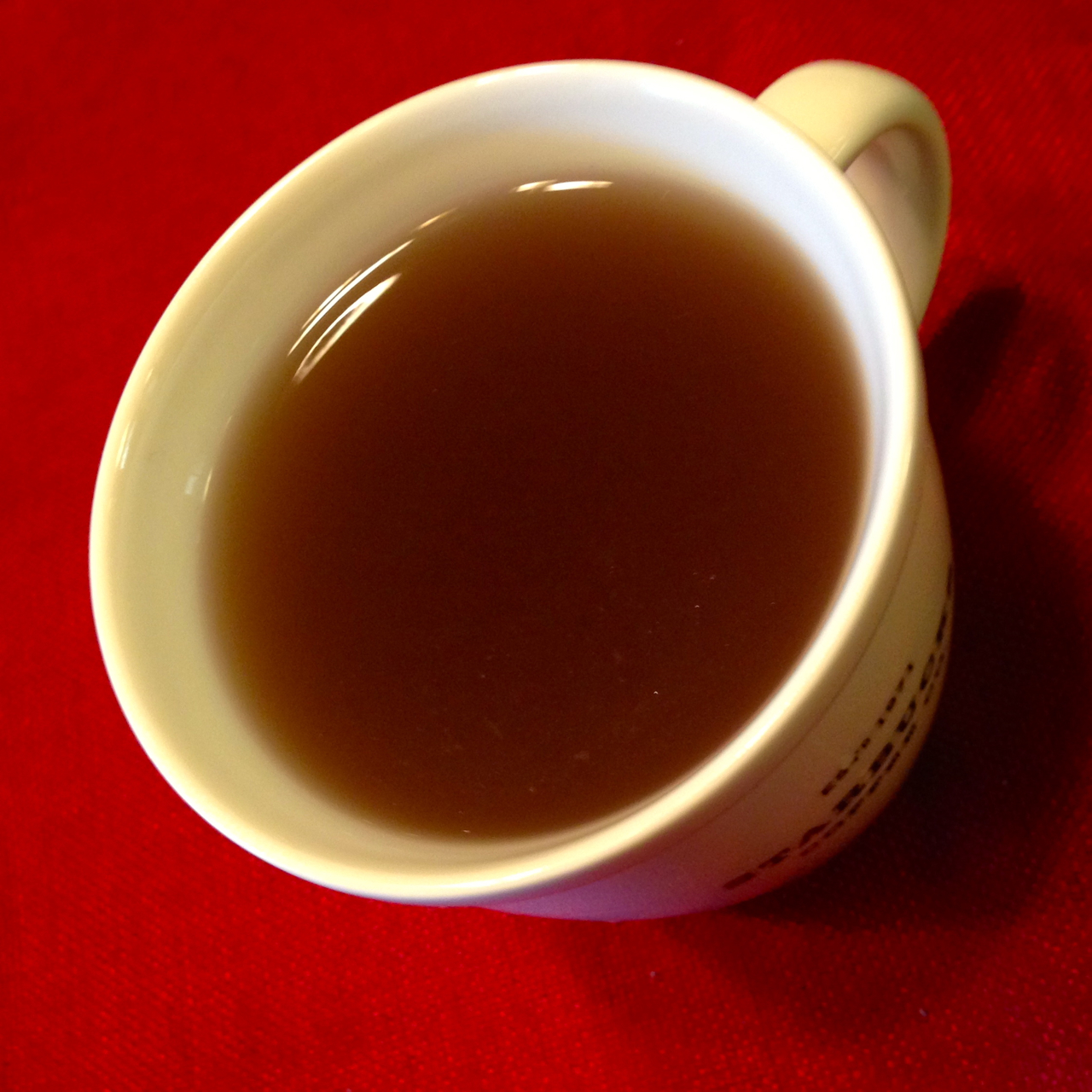
by Michelle Dwyer | Jan 1, 2015 | Blog, Health, Nutrition, Recipes, Vegetarian/vegan
I don’t know about you, but I love a warm cup of vegetable broth. Right now I’m sipping a large mugful as I recover from a bit of over-indulgence over the holidays. I’m also hoping to keep a cold at bay by drinking as much broth as possible. A cup of delicious broth can also make for a satisfying small meal or help keep you warm on a cold day. This broth also makes a great base for any number of soups. There are a lot of great broth recipes out there, but the one I’m going to share with you is based on the Magic Mineral Broth recipe made famous by Rebecca Katz in One Bite at a Time.
Vegetable Broth
Ingredients:
- 2 unpeeled carrots, cut into thirds
- 1-2 unpeeled medium onions, including peels/skin, cut into chunks
- 3-4 stalks celery, including the heart, cut into thirds
- 1 head of garlic, including peels/skin, roughly chopped
- few inches of fresh ginger root, roughly sliced
- 1/2 bunch fresh flat‐leaf parsley
- 1 sweet potato or yam with skins on, quartered
- 1 8‐inch strip of kombu seaweed (available at Whole Foods, online or if you live in Oakland, HERE)
- 2 bay leaves
- 12 black peppercorns
- 4 whole allspice or juniper berries (optional)
- 1 tablespoon quality sea salt (note: if I’m going to cook beans with the broth, I leave the salt out)
Note: Adjust the amount of ingredients to the size of your stock pot. Also, I often use vegetable scraps to make my broths (see below for more info on using scraps). Other vegetable choices (depending on the flavor profile you want and what you have on hand) can include mushrooms, leeks, fennel, greens, fresh herbs, parsnips, and potatoes.
Directions:
- Rinse all the vegetables well to remove any dirt.
- In a large stockpot, combine all the ingredients except the salt. Fill the pot to 2 inches below the rim with water, cover, and bring to a boil.
- Remove the lid, decrease the heat to low, and simmer a minimum of 2 hours. As the stock simmers some of the water will evaporate. Simmer until the full richness of the vegetables can be tasted. I like to try and simmer mine for as much as 4 hours or more.
- Add the salt and stir (unless you plan to use the broth to cook dried beans).
- Let stock cool in pot until room temperature.
- Strain the stock using a large coarse‐mesh strainer (remember to use a heat‐resistant container underneath) and/or cheese-cloth or clean linen towel. Compost the cooked vegetables.
Makes 6 to 7 quarts, depending on stockpot size.
Broth can be frozen up to 6 months in a variety of airtight container sizes for every use.
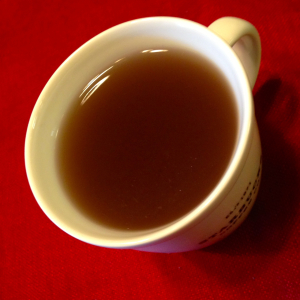 Tips for what to do with your broth:
Tips for what to do with your broth:
- You can add a little tamari, Bragg’s amino acids, coconut amino acids, or miso to your broth for a little added flavor.
- I also often add some coconut oil for a bit more substance.
- If you are not vegetarian/vegan, you can also add some gelatin for added protein.
- When I’m making broth to really support my immune system, I will add A LOT more ginger and garlic to the initial broth ingredients. You can also add dried or fresh shiitake mushrooms, oregano, reishi mushrooms, and/or astragalus root.
- Again, broth can be sipped alone or used as a base for any soup.
- Broth is really great to drink when recovering from surgery, illness or chemotherapy. It is a great way to get nourishment for your body without putting too much stress on your digestive system.
- To store leftover broth, I put them in mason jars to drink over the week and then freeze the rest.
Using vegetable scraps:
One of my favorite ways to make vegetable broth is to use leftover vegetable scraps. Not only does this reduce waste and save money, but often the foods we consider “scraps” contain great nutritional benefits!
- When cooking any meal, save your cleaned vegetable scraps in a plastic freezer bag and store in freezer until ready to make into broth. I just keep adding ingredients to bags until I’m ready to make broth (or the freezer gets full!).
- Good “scraps” to include are carrot peels, carrot tops, celery tops and bottoms, fennel tops, leek green tops, onion and garlic skins, broccoli and cauliflower stalks, stems from herbs like parsley, green tops of radishes, turnips or beets (just note that if you use beet greens, your broth will turn red!). I also added any vegetables that we didn’t get a chance to eat in the week that may be going a little limp.
- Just dump the frozen vegetable scraps into your pot, add in some fresh vegetables that may not be included in your frozen bag, and then follow the directions from above!
I would love to hear from you. Have you made your own broth? What tips or suggestions do you have?
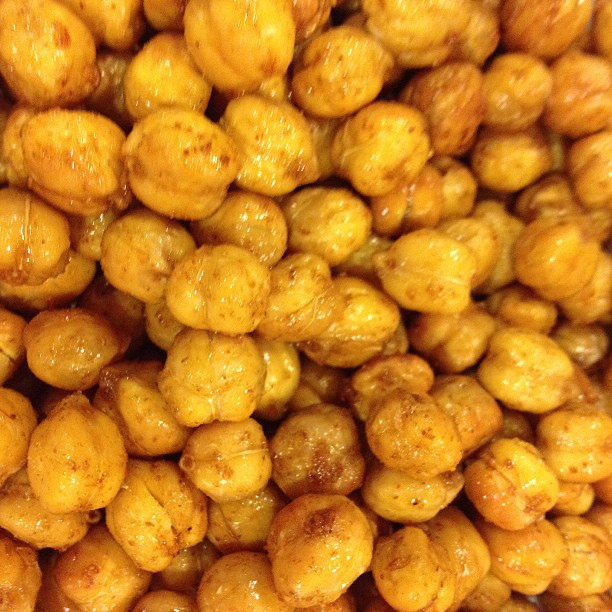
by Michelle Dwyer | Oct 23, 2014 | Blog, Health, Nutrition, Recipes, Vegetarian/vegan
Many people benefit from eating every 3 to 4 hours. A great way to be sure your body is getting the energy it needs is to eat a mid-morning and/or afternoon snack. Snacks are generally smaller and lighter than meals, but look for ones that are nutrient-rich. Nutrient-rich means that the food is concentrated in vitally important vitamins, minerals, antioxidants, phytonutrients, fiber, and energy.
Many of these items can be mixed and matched. For instance, add some almond butter to your apple or swap the tortilla for gluten free crackers for your avocado salsa. Adding enjoyment and variety to your snacks makes them more enjoyable for you and also adds different nutrients to your diet. Also, be sure to consider your own biochemical individuality—what works for YOUR dietary system and nourishes YOU—when choosing healthy snacks!
Nuts or seeds like almonds, walnuts, sunflower seeds or pumpkin seeds—raw & unsalted (1/4 cup = 1 serving)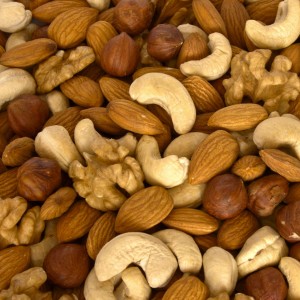
Nutrition: Good source of protein & healthy fats; also good sources of fiber, calcium, magnesium, manganese, zinc, folate, vitamin E, & B vitamins; varies depending on nut/seed.
Tips: Remember that 1/4 cup is a serving size, so enjoy but do not over-‐indulge. Many people find nuts and seeds easier to eat and digest if they have been soaked or sprouted first.
Hummus or other healthy dip and veggies (carrots, celery, red bell pepper, broccoli, radish or pea pods)
Nutrition: Fiber, phytonutrients, & vitamin C. Carrots are also a great source of vitamin A, K, biotin and fiber. Celery is a good source of potassium, and vitamins B6 & B1.
Tips: These are easy to pack ahead of time and make for a yummy, crunchy snack. For some other healthy dip ideas, check out this artichoke dip or this olive pistachio dip or this vegan pesto!
Almond butter and whole-grain, seeded crackers like Mary’s Gone Crackers (2 T. almond butter & about 7-10 crackers)
Nutrition: For benefits of almond butter, see nuts/seeds above. Whole-grain crackers are higher in fiber & other minerals than crackers made with enriched flour.
Tips: Look for crackers without a lot of additives and ingredients; simple is best.
Whole grain or corn tortilla, avocado and salsa
Nutrition: Avocados are good sources of fiber, vitamin C, E, K, folate & potassium. Tomatoes are great sources of vitamin C, biotin vitamin K, carotene & lycopene.
Tips: Use about a ½ avocado in a serving. For the other half, leave the pit in the fruit and place in the refrigerator in a sealed container—it will keep for the next day.
Fruits like apples, oranges, berries, plums, or pears
Nutrition: Good amounts of antioxidants, fiber, phytonutrients, vitamin C; amounts vary depending on the fruit
Tips: It sounds so simple but fruits with a high fiber count can be quite filling and refreshing as a snack. Can pair with some almond butter for some added fat and protein.
Roasted seaweed
Nutrition: Good source of vitamins A and C and iodine.
Tips: This delicious snack is a great way to add sea vegetables to your diet. Great as an after-workout snack! The iodine in seaweed can help regulate hormones like estrogen and thyroid.
Roasted chickpeas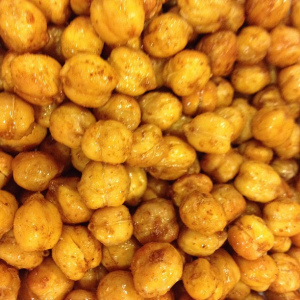
Nutrition: Excellent source of phytonutrients, molybdenum and manganese. They are also a very good source of folate and copper as well as a good source of dietary fiber, phosphorus, protein, iron, and zinc
Tips: Make these yourself because the ones in the store are usually full of added sugar. For an easy recipe, check out here or here.
Edamame
Nutrition: High in protein and low in fat; good source of fiber, thiamin, iron, magnesium, phosphorus and copper, vitamin K, folate & manganese.
Tips: You can get shelled edamame in the frozen food section of most stores. Add soy sauce, tamari or Bragg’s if you want some flavor. If you have thyroid issues or a food sensitivity to soy, you will want to avoid soy products.
Baked kale
Nutrition: Good source of vitamin A, vitamin C, calcium, and potassium.
Tips: Great for if you want something crunchy and savory with the benefits of kale. Easy to make yourself or can get at the store.

 Health Benefits:
Health Benefits:













